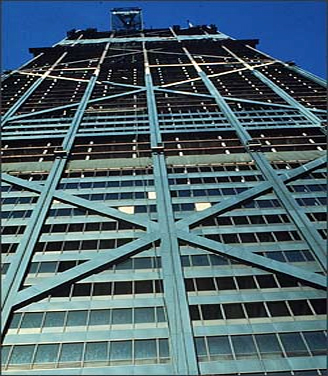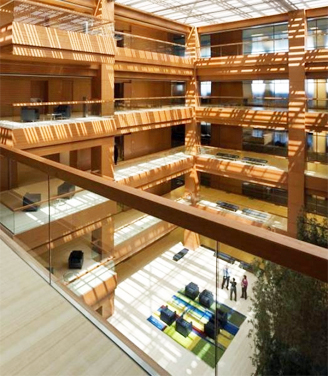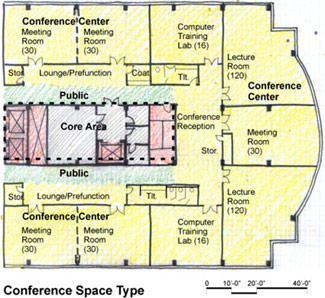Overview
Within This Page
This branch of the WBDG is designed to provide guidance to architectural and engineering design professionals to better understand the basic processes, techniques, and language by which functional and operational building decisions are made.
A clear understanding of the functional and physical requirements of a project is essential to ensuring its success. A client's / owner's intent to develop a project is derived from a need, a purpose or mission, and a desired result. When the design of a facility satisfies the emotional, cognitive, and cultural needs of the people who use it and the technical requisites of the programs it houses, the project is functionally successful. Program and functionality are also characterized by building type. A building that functions as it is intended is the underpinning of a quality "whole" building. The qualities of such a building may not even be noticed or recognized, but a poorly functioning building can be costly to correct, if the opportunity to correct ever becomes available. When designs fall short of this goal, the cost can be modest to extreme, but the failures are generally noted more significantly than the expected successes.
Information in these Functional pages must be considered together with other design objectives and within a total project context in order to achieve quality, high-performance buildings.


Exterior lateral bracing created open interior spaces at the John Hancock Building—Chicago, IL
Photo Credit: Skidmore, Owings and Merrill LLP
CalPERs Headquarters Complex daylit interior atrium space in the building's core
Development in the building sciences in the late 1900's has pointed to the need to refocus on programming, designing, constructing, and operating facilities that function well, while at the same time incorporating new technologies, and creatively meeting other design objectives: sustainability, accessibility, safety, aesthetics, cost effectiveness, productivity, and historic preservation. Addressing these design objectives while achieving energy savings, and improving environmental quality is paramount in designing the "whole" building. Facility Performance Evaluations have shown that early programming and design decisions have significant impact on the functional quality, and long-term efficiency and effectiveness of buildings, initially and over their life cycle, such as:
- Adaptability: decisions at the inception of project design to incorporate elements and concepts that will assist with future adaptations to a building can facilitate change in the future:
- Building to readily facilitate horizontal and vertical expansion
- Analyzing the building structural concept, i.e. structural grid, dimensions, and floor-to-floor heights that allow for flexibility in internal layouts
- Functional Quality: decisions to incorporate the use of hard walls for offices and workspaces vs. flexible 'furniture' systems have a significant impact on functionality of a building.
Adopting an integrated design approach and quality assurance processes that extend through all of the phases of design and construction of a project, from pre-design through owner occupancy and operation, with checks at each stage of the process will help ensure validation of decisions to meet the owner's program and design requirements. Buildings that are more functionally successful also create more inspiring, safe, and productive environments that enhance work and/or livability.

Many different metrics can be a part of measuring the performance of buildings. (See also Measuring Performance of Sustainable Buildings for more information.)
A building is considered to perform at a high level when all key design objectives are considered from the early project development phase, rather than focusing on one design objective while others are trivialized or overlooked all together. For example, most projects have both sustainability and security goals that must be met. Discussing these early on can help ensure a project's functionality goals are met as well as its productivity goals. The ability to measure the performance of sustainable buildings can also help achieve the functional and productive goals of the project.
There are three overarching principles associated with ensuring functional building design and operations:
- Account for Functional and Psychological Needs
Identifying the spatial requirements and psychological needs developed in the functional program is a primary element of the planning process that translates to an owner's spatial and service requirements for a building or facility. Key tasks in this process are: problem definition or statement, establishing goals, collecting and analyzing facts, establishing functional relationships, and uncovering and testing concepts. There is also a need to design for flexibility of programmed space. -
Ensure Appropriate Product / Systems Integration
A successfully designed building that functions properly in all respects is composed of building systems, materials, and technologies that are selected and integrated to be mutually supportive as a cohesive "whole" system. - Meet Performance Objectives
Meeting performance objectives is not achieved simply by a "Final Inspection" of the finished product, but is a sustained effort from inception and planning through turnover and operation to assure the delivery of a project that satisfies all of the owner's functional, psychological, and operational requirements for the project. There are many aspects involved in assuring performance objectives are met, from assembling a qualified project delivery team; to adequately coordinating team member roles and responsibilities; to instituting systematic quality assurance programs, like Building Commissioning.

Relationship of Function / Operation and Cost
Building functional and operational goals are most successfully met within the constraints of a project budget when cost estimation occurs early in the design process and is continually refined/updated as design progresses.
Most projects have a budget to meet. Good planning and design practice involves identifying project functional and operational goals and needs during the programming phase. It is often helpful to prioritize goals and needs, and to carefully distinguish needs from wish list items. Many public sector projects have standardized processes with milestone reviews occurring at programming, schematic design, design development, and construction document phases. Updating the cost estimate throughout the design process and at each milestone helps avoid costly surprises late in the design phase. It is much easier to make changes to a project in order to align with the budget early in the design process rather than later.
Cost-cutting, or value engineering, late in the game often sacrifices quality or performance. The designer is afforded a much better opportunity to address cost and budget alignment holistically without sacrificing functional priorities if cost concerns are identified early in the process. For example, the insulative value of a building envelope affects the sizing of the HVAC system. Downgrading the building envelope to save cost after the building has already been designed could result in an HVAC system that is improperly sized to maintain thermal comfort levels, or an HVAC system that needs to run harder than it was designed for, thus reducing the system lifespan and driving up building operation costs.
Several cost control best practices include the following:
- Establish and prioritize project goals, needs, and wants early in the design process. (i.e. during programming)
- Update the cost estimate throughout the design process and definitely at project milestones. (i.e. Programming, Schematic Design, Design Development, Construction Documents)
- Verify the cost estimate with historic project cost data and industry professionals.
- Balance project first costs with life-cycle costs.
- Identify opportunities for flexibility on bid day; use bid lots or bid alternates.
Design Lessons Learned
Key to improving the facility planning, design, and delivery process is continual improvement of team performance through learning from and avoiding repeated design errors, omissions, or flaws in project execution. "Lessons Learned" is a common term that refers to an organization's compilation and publication of the lessons for the knowledge and benefit of future project teams.
Design of facilities that meet or exceed the functional expectations of owners and facility managers will require the application of these principles as well as thorough understanding of historical precedent and knowledge of current design practices for the building type.
Additional Resources
Codes and Standards
- Assessment to the U.S. Congress and U.S. Department Of Energy On High Performance Buildings , by the High Performance Building Council of the National Institute of Building Science, 2008.
- Living Building Challenge—is a green building rating system of the International Living Future Institute.
- PBS-P100 Facilities Standards for the Public Buildings Service, GSA—Establishes integrative performance standards for federal facilities.
- Green Globes—is a green building rating system by the Green Building Initiative in the U.S. and BOMA in Canada.
- ICC Codes—Search for ICC codes by state
- Leadership in Energy and Environmental Design (LEED® v4) Green Building Rating System™ is a program of the U.S. Green Building Council.
- Standard 189.1, Standard for the Design of High-Performance Green Buildings Except Low-Rise Residential Buildings, jointly developed by ASHRAE, USGBC, and IES. A minimum standard to mainstream high-performance building practices.
- Standards for Whole Building Functionality and Serviceability, 3rd Edition by ASTM. 2000. ASTM Stock #: WBDG2009, ISBN13: 978-0-8031-8006-2.
- WELL Building Standard—Administered by the International WELL Building Institute™ (IWBI).
Publications
- ADA/ABA Accessibility Guidelines for Buildings and Facilities
- Architectural Graphic Standards, 12th Edition by The American Institute of Archtiects. New York, NY: John Wiley & Sons, Inc., 2016—The most widely recognized reference manual for architectural design guidance on planning, design standards, building systems, materials, methods, and construction techniques.
- The Architect's Studio Companion: Rules of Thumb for Preliminary Design, 6th Edition by Edward Allen and Joseph Iano. New York, NY: John Wiley & Sons, Inc., February 2017.
- ASHRAE Handbook — Fundamentals by ASHRAE Handbook Committee. Atlanta, GA: American Society of Heating, Refrigerating and Air-Conditioning Engineers, Inc. 2017.
- ASHRAE Handbook of HVAC Systems and Equipment by ASHRAE Handbook Committee. Atlanta, GA: American Society of Heating, Refrigerating and Air-Conditioning Engineers, Inc. 2020.
- Mechanical and Electrical Equipment for Buildings, 12th Edition by Walter T. Grondzik, Alison G. Kwok. New York, NY: John Wiley & Sons, Inc., 2014.
- Time-Saver Standards for Building Types, 4th Edition by Joseph DiChiara and Michael J. Crosbie. McGraw-Hill, Inc., 2001—A comprehensive reference for building type design guidance, including sample projects with plans and illustrations of functional features and details.
- Time-Saver Standards for Interior Design and Space Planning by Joseph DeChiara, Julius Panero, Martin Zelnik. New York: McGraw-Hill Inc., 2001.
- Time-Saver Standards for Landscape Architecture by Charles W. Harris, Nicholas T. Dines. New York: McGraw-Hill Inc., 1997.
- Time-Saver Standards for Urban Design by Donald Watson. New York: McGraw-Hill Inc., 2003.
Associations
The following are major associations representing design professions that publish resources and set practice standards for the planning and design of facilities.
- American Council of Engineering Companies (ACEC)
- The American Institute of Architects (AIA)
- American Planning Association (APA)
- American Society of Civil Engineers (ASCE)
- American Society of Heating, Refrigerating and Air-Conditioning Engineers (ASHRAE)
- American Society of Interior Designers (ASID)
- American Society of Landscape Architects (ASLA)
- American Society of Mechanical Engineers (ASME)
- Institute of Electrical and Electronics Engineers (IEEE)
- International Council for Research and Innovation in Building and Construction (CIB)
- International Interior Design Association (IIDA)
- National Charrette Institute (NCI)
- National Research Council Canada, Construction Division
- National Society of Professional Engineers (NSPE)
- SAVE International
- Union of International Architects (UIA)








